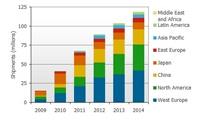Forty million Internet-connected TVs projected for sale this year
“It has been a long, challenging journey so far, especially with new competitors like Google TV joining the battle,” Gray said. “Set makers will have to acquire new skills such as negotiating content deals in order to succeed.”

Calling it a “quiet revolution,” consumer electronics research firm DisplaySearch predicts that more than 40 million Internet-connected TV sets will be shipped worldwide in 2010, with the number growing to 118 million by 2014.
DisplaySearch also said the market will split between more basic connected units and so-called smart TVs that will have configurable apps, sophisticated search and navigation engines and advance user interfaces.
While marketing efforts have focused on 3-D television, Internet television has taken off and will likely heat up the competition between multichannel programmers such as cable and satellite vendors against Internet providers of video programming.
In fact, on 3-D, DisplaySearch predicted that only 3.2 million 3-D TV sets will be sold worldwide this year. That’s about 2 percent of all flat-panel TV shipments.
“It’s an exciting time for the connected TV sector,” said Paul Gray, DisplaySearch’s director of European TV Research. “It’s a battleground where TV set makers, Internet video companies, free-to-air broadcasts, pay-TV and the IT industry are all rushing to stake their claim.”
“I think most of the TV supply chain senses that this is a seismic shift in the usage of TV that will be far more significant than 3-D, which will not alter TV function or usage patterns,” he said.
Get the TV Tech Newsletter
The professional video industry's #1 source for news, trends and product and tech information. Sign up below.
On the negative side, DisplaySearch analysts cautioned that consumers around the world remained confused about the technology. A recent DisplaySearch report found that only 10 percent of the connected TVs sold in Japan have actually been hooked up to a network.
